Table of contents
- Motorcycle trip in the Baltic States Lithuania, Latvia and Estonia
- The Baltic Sea is becoming a really wild sea
- A quiet journey through an uneventful country
- Numerous lakes and small cozy villages
- Off to Estonia
- Relaxed cruising and hardly any traffic
- Further information

Jo Deleker
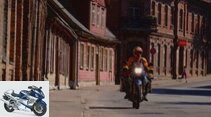
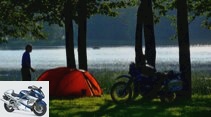
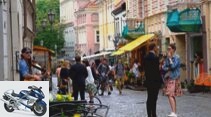
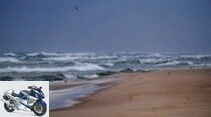
17th pictures
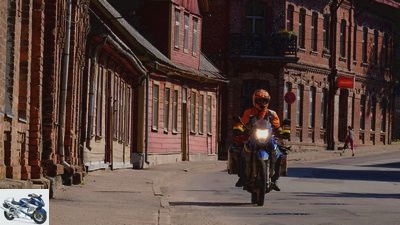
Jo Deleker
1/17
Motorcycle touring in the Middle East of Europe.
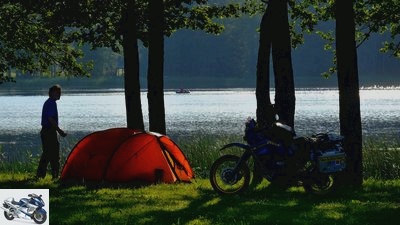
Jo Deleker
2/17
Peace in its purest form. Those who want to come down are ideally positioned on a motorcycle hike through the Baltic countries.
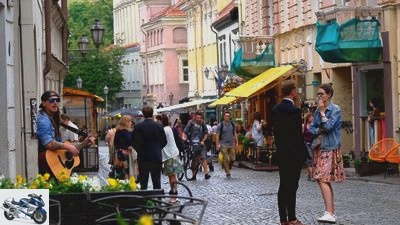
Jo Deleker
3/17
The capitals of the Baltic countries, here Vilnius, are modern, vibrant metropolises with a strong character.
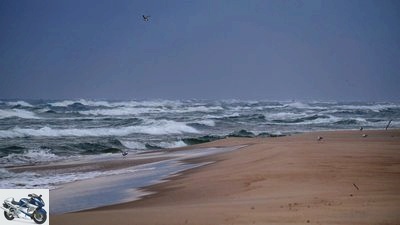
Jo Deleker
4/17
The Baltic Sea, churned up by the storm, with endless, deserted sandy beaches near Nida.

Jo Deleker
5/17
There is also the Amber Museum here, where you can marvel at insects that have been trapped in the fossil resin for millions of years.
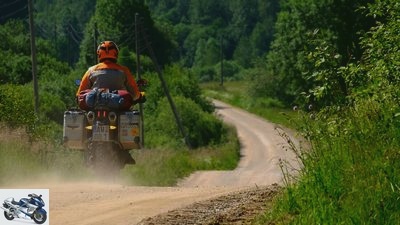
Jo Deleker
6/17
Boring to drive? No! There are many diverse end-Europeans here near Ergli in Latvia.
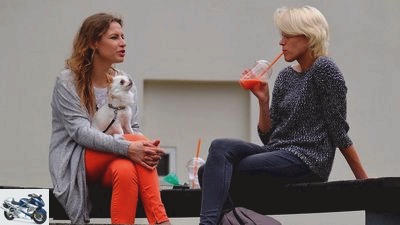
Jo Deleker
7/17
City scene with cosmopolitan women in Vilnius.
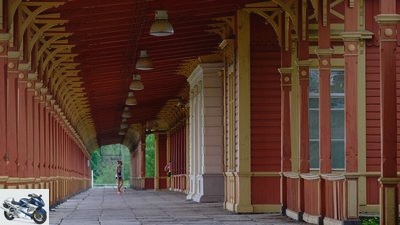
Jo Deleker
8/17
The 110-year-old, well-restored Haapsalu train station in Estonia.
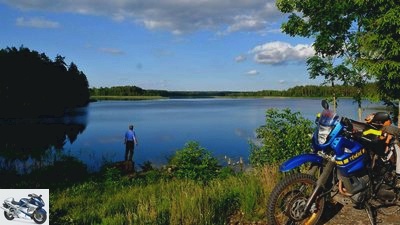
Jo Deleker
9/17
Once again, total relaxation at one of the countless lakes in eastern Lithuania.
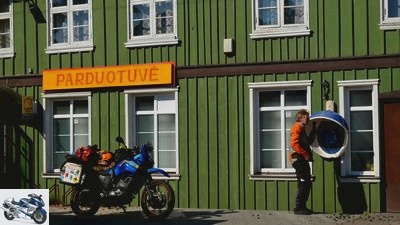
Jo Deleker
10/17
Village shop in the old center of Rusne in Lithuania.
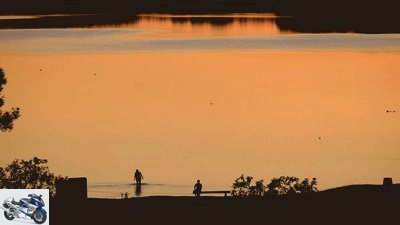
Jo Deleker
11/17
In the evening at eleven a swim in the lake near Paluse.

Jo Deleker
12/17
The wet lowlands of the Baltic States are a paradise for storks. Here is a white stork.
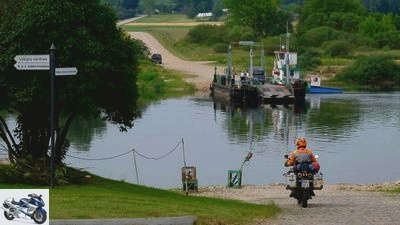
Jo Deleker
13/17
The coziest job in Lithuania: the ferry across the Memel only runs when someone comes.
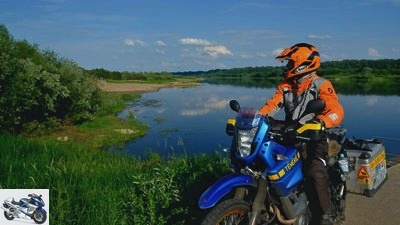
Jo Deleker
14/17
Here motorcycle hiking becomes a pleasure.
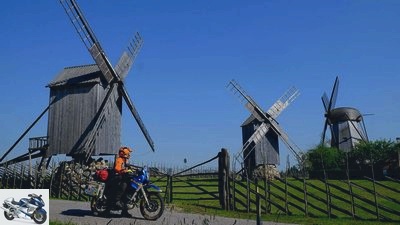
Jo Deleker
15/17
The old Angla windmills on Saaremaa Island in Estonia.
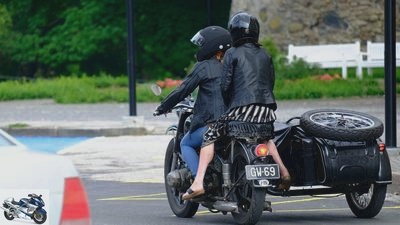
Jo Deleker
16/17
Two ladies from Finland are cruising through Haapsalu with their old BMW team.
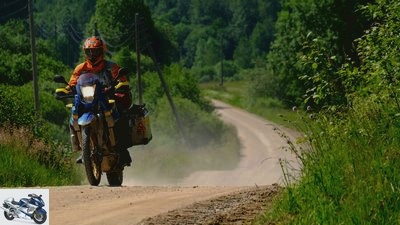
Jo Deleker
17/17
The plain gets bumps and depressions, hills and valleys.
to travel
Motorcycle tour Baltic States Lithuania Latvia Estonia
Motorcycle trip in the Baltic States
Lithuania, Latvia and Estonia
Mountains, passes and spectacles are completely alien to the Baltic States. The calm landscape and the lively old capitals are the greatest assets of Lithuania, Latvia and Estonia. Motorcycle touring in the Middle East of Europe.
Joachim Deleker
14.09.2018
Four weeks ago I didn’t even know the geographically correct order of the three Baltic states, Lithuania, Latvia and Estonia. But while the squeaky clean DFDS ferry plows through the calm Baltic Sea from Kiel to Klaipeda, I have enough time to tune in to the unknown countries. The travel guide arouses curiosity and makes you want to explore, which begins in Klaipeda. The city was Germany’s northernmost until 1920 and was called Memel until 1945. Traces of history, sometimes melancholy, sometimes horrific, that I will encounter in the next two weeks.
Buy complete article

Motorcycle trip in the Baltic States
Lithuania, Latvia and Estonia
10 pages) as PDF
€ 2.00
Buy now
The Baltic Sea is becoming a really wild sea
A small ferry takes me and the Tenere over to the Curonian Spit, Unesco World Heritage, an almost 100 kilometers long and very narrow headland that separates the Curonian Lagoon from the Baltic Sea. Actually, the spit is a single long dune, today mostly reforested with pine forests, which means that the dunes have no longer been used to hiking. I can drive as far as Nida, the beautiful main town, then the border prevents further progress. All that remains is the view over the endless and deserted sandy beach over to Russia.
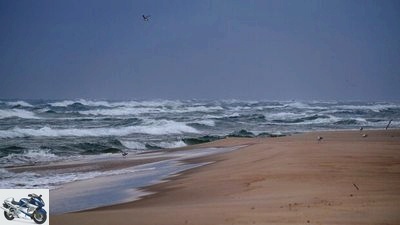
Jo Deleker
The Baltic Sea near Nida.
Overnight, an unusually strong summer storm stole all traces of the beach, felled various trees and turned the otherwise so tired Baltic Sea into a really wild sea. The surf roars wide and white on the beach, heavy rain showers wander along the horizon. Nice weather. The summer idyll has a break. Time to look at the old and cozy fishermen’s houses in Nida and to marvel at the amber museum about spiders, flies and mosquitoes that were forever trapped in the yellow clumps of fossil resin 20 million years ago. Maybe one of the mosquitoes still has drawn dinosaur blood in its stomach?
A quiet journey through an uneventful country
Enough of the spit, I would like to follow the Memel, which is now called Nemunas, to the capital Vilnius. A quiet journey through an uneventful country, forest and meadows, many storks, here and there a village where time has sneaked by almost without a trace. The big river is silent, not a wave ripples in the dark water, slowly and slowly it pushes towards the Baltic Sea. Cyclists wear safety vests, but no helmets. Pedestrians wear safety vests and large, colorful shopping bags. A woman is milking a cow in a pasture. The woman is wearing a safety vest, the cow is not yet. There is never any hectic here, the years flow by just as calmly as the river. A yellow sign points to Tilsit, which is now called Sowetsk, only five kilometers away, but not reachable because the old East Prussian city is now in Belarus on the other bank of the Memel.

Jo Deleker
The ferry only runs when someone comes.
Days later I’m in Vilnius, a city of half a million. Another world. I camp on the outskirts and drive to the center in a jarring, old-fashioned electric bus. The driver does not want to be spoken to, even selling tickets seems to be a mental torment to her. Perhaps she has been driving this bus for 40 years, the rustic couple has assimilated over the decades, sullen and forced to function. The passengers are teenagers and mothers paddling on their mobile phones, who perfectly fulfill the Russian cliche of a little too buxom, a little too blonde and a little too covered in make-up. It goes through ugly prefabricated housing estates to the center of Geležinkelio Stotis. A difficult word for station.
Numerous lakes and small cozy villages
But then: Vilnius has none of the previous melancholy, the wide and lively boulevards, the great old town with monumental buildings, cafes like in Italy, a motley crowd, spacious squares, that is world-class. Almost everything has been perfectly restored, the old university is an architectural dream, from its 68 meter high and over 400 year old tower I look out over the old city with its 50 churches. I stay in Vilnius for three days, much longer than planned, I am fascinated by the aura, I am shocked when I visit the KGB Museum with its torture cellars, where thousands of regime critics were murdered. If that’s not enough horror: Two streets away, the Holocaust Museum reminds you of the 200,000 Jews who were killed by the Nazis in Lithuania.
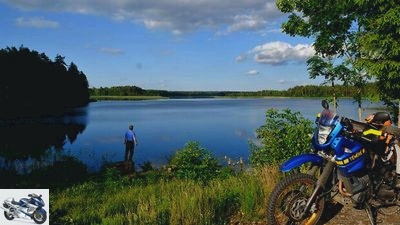
Jo Deleker
One of countless lakes in eastern Lithuania.
Cut. Take a deep breath and switch back to land mode. Which is not easy after the strong impressions of the capital. I’m aiming for a north-east course, straight to “Lithuanian Switzerland”. In fact, the plain gets bumps and depressions, then even rolling hills and indicated valleys, numerous lakes and small cozy villages garnish the Aukštaitija National Park, the road gains a little height in gentle turns, just scrapes past the fourth highest “mountain” in the country, the Nevaišiu , precisely 289 meters high. After all.
Off to Estonia
And further, down into the plain to Zarasai, over the barely recognizable border to Latvia and on to the banks of the Daugava. A mighty river, at 1,020 kilometers almost as long as the Elbe, and yet I’ve never heard of it. Terra incognita, that’s one of the reasons why I’m here to discover new things. A dusty dirt road runs northwest through the shimmering midday heat on the banks of the calm stream. Every now and then Latvians in Volkswagen, Hyundais or Dacias come towards them at rally speed, pulling mighty clouds of dust behind them, showing no consideration whatsoever. You want to get there in time for the midsummer evening party. Today is June 23, St. John’s Eve, the most important national holiday. The country will celebrate four days loud and boozy, shops are closed, the streets are empty. Is it a coincidence that so many Latvian cities end in -pils? Jekabpils, Daugavpils, Ventspils, Salaspils. Cheers. But there are other images that Latvia conveys to me. Quiet landscapes devoid of any drama, magnificent manor houses that were inhabited by the German landed gentry for many generations until the expropriation and displacement after 1920, the first Russian Orthodox churches, long evenings thanks to the same northern location as Scotland, the paddler’s paradise in the Gauja National Park and great old cities like Jakobstadt or Cēsis. Images that radiate one thing above all else: calm.
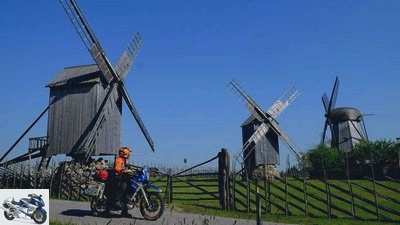
Jo Deleker
The old windmills of Angla.
That doesn’t change when I cross the border again, now to Estonia. New country, and another language I don’t understand anything about. Estonian sounds and looks like Finnish. I follow the Baltic coast, enjoy the fresh sea air, board the ferry over to the largest island in the country, to Saaremaa. I had read a tantalizing story about this island in some magazine. And now I am here, crossing almost 300 kilometers through flat green land, meadows and forests, rarely looking at the Baltic Sea, the constant absence of charm, just the nice old windmills of Angla and the fat castle of Kuressaare, that’s it. So back to the mainland to Haapsalu. Much better. A nice small town with Scandinavian flair, colorful wooden houses, the cozy center with the ancient castle and the beautifully restored old train station, which the Russian tsar himself had built 110 years ago in order to be able to travel comfortably to his favorite health resort. Three steam locomotives, two Russian and one German 52 freight locomotive, slumber in front of the platform. Haapsalu has a feel-good atmosphere.
Relaxed cruising and hardly any traffic
There are hardly any traces of the Soviet occupation left here. After independence, Estonia switched to the future surprisingly quickly. Free public Wi-Fi is available almost everywhere, hardly any country has dedicated itself to the Internet in such a way. Lithuania and Latvia are developing more slowly, but even there I am amazed at what the Baltic countries have achieved since 1991. Without any trillion dollar support from the West, which caused rapid development and transformation in the ex-GDR. The Baltic countries had to do everything themselves, master the elimination of the old Russian markets and still managed to do it. That deserves respect!
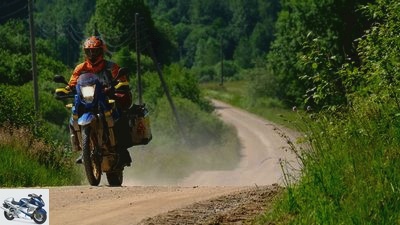
Jo Deleker
The Baltic region surprises with many beautiful motorcycle routes.
One more day to Tallinn, as usual relaxed cruising on almost traffic-free back roads through the green and flat world, counting cows and storks, watching the Tenere’s speedometer collecting kilometers. And then the capital of Estonia, Tallinn, the former Reval. Tallinn is different, Tallinn fascinates, Tallinn is ultra-modern despite its medieval core. No other Hanseatic city is as well preserved as Tallinn, a closed ensemble of large trading and town houses, all 400 to 700 years old. If you were to roll a historical ham from the heyday of the Hanseatic League, Tallinn is the perfect stage, you don’t need a contemporary backdrop here, everything is real. And yet not dead in a museum, but very much alive, almost Italian. The next surprise. Like the whole of the Baltic States. Where, despite all prejudices, there are even really fun motorcycle routes. It’s good that I was finally here, filling white spots on my personal map with color. Terra incognita was yesterday.
Further information
The Baltic States, three small countries between Poland and Russia. Green, flat and sparsely populated, at the same time exciting and relaxing with traces of German and Russian history. The highlights are the respective capitals Vilnius, Riga and Tallinn.
General: The three Baltic countries are about half the size of Germany, but only 6.1 million people live here, compared to 82 million in Germany. In 1991 the three countries separated peacefully from the USSR, have been independent since then and became members of the EU in 2004, but also of NATO, which was politically very controversial. Every country has its own language, but now the common currency is the euro.
Getting there: The easiest and fastest way to get there is via the Baltic Sea. Every evening a modern high-speed ferry from DFDS leaves Kiel and reaches Klaipeda in Lithuania 20 hours later. Costs for one person plus motorcycle from 98 euros. Info: www.dfdsseaways.de. Somewhat cheaper, less comfortable and eight hours slower are the Stena ferries, which sail from Travemunde to Liepaja in Latvia and dock there at 1 a.m. Info: www.stenaline.de. The overland route leads through Poland. It covers around 1,700 kilometers from Cologne to Klaipeda.
Travel time: From mid-May, the nights are short, the precipitation is liquid, but not more frequent than in northern Germany, and the temperatures are roughly the same as in Denmark or southern Sweden. Autumn comes in mid-September.
money & Papers: The common currency is the euro. There are plenty of cash machines available for replenishment of cash. Lithuania and Latvia are significantly cheaper than Germany, Estonia is not. The “EU standard equipment” is sufficient to enter the country: identity card, vehicle registration document and driver’s license.
Streets: Mostly well paved, especially the highways. But if you are looking, you will also find a dense network of mostly legal and passable slopes. In Latvia in particular, some minor roads are not paved.
Accommodation: Campsites are inexpensive and often beautifully located. Guesthouses and hotels are few and far between in the country, but are plentiful in the big cities. The easiest way to pre-book is via www.booking.com or with the help of a good travel guide. The spontaneous search can sometimes be annoying because the hotels or B&B are often poorly signposted.
Books & Cards: The Baltic Travel Guide from Reise-Knowhow-Verlag has proven itself very well. More than 900 pages thick, still handy, full of helpful information, 24.90 euros. Lonely Planet also offers a Baltic Guide for the same price. To get in the mood, the DuMont picture atlas costs 9.90 euros. There are also good maps from Reise-Knowhow, three individual sheets of the countries and an overall map for the Baltic States. Costs per sheet 9.95 euros.
Information on the net:
- www.litauen-info.de
- www.baltikuminfo.de
- www.infobalt.de
- www.visitneringa.com
- www.latvia.travel/de
- www.visitestonia.com
- www.visittallinn.ee
Countries:
- Lithuania, Latvia, Estonia
Capital Cities:
- Vilnius, Riga, Tallinn
- Population: 6.1 million
- Country area: 175,000 km²
- Currency: Euro
Related articles
-
MOTORCYCLE on the road: Baltic States
Kirsten Fiege to travel MOTORCYCLE on the road: Baltic States MOTORCYCLE on the road: Baltic States Experience of loneliness Hardly any curves and only…
-
to travel Baltic states Baltic states Different than expected Beaches like on the Mediterranean, cappuccino like in Italy and magnificent buildings that…
-
Motorcycle tour Cuba: more than just a relaxing vacation
Thorsten Dentges 35 pictures Thorsten Dentges 1/35 Blue sky, turquoise sea, white sand – this is how we know Cuba from the catalog and this is how it can…
-
Motorcycle tour through Algeria
to travel Motorcycle tour through Algeria Motorcycle tour through Algeria The dunes of the Sahara Algeria. The grave road, the sand dunes from Erg…
-
MOTORCYCLE tour tip – East Westphalia
Tour tips Exclusive motorcycle tours for children to follow Presented by Jo Deleker to travel MOTORCYCLE tour tip – East Westphalia MOTORCYCLE tour tip -…
-
Lorenz to travel Poland and the Baltic States Poland and the Baltic States Stars in the east Estonia, Latvia and Lithuania: Completely different in…
-
Deleker 22nd pictures Deleker 1/22 The myth of Aphrodite, the goddess of love, ruled life in Cyprus for 2,700 years. Especially the mind of men. Deleker…
-
Motorcycle tour Armenia – Ararat Caucasus
Jo Deleker 18th pictures Jo Deleker 1/18 Jo Deleker 2/18 The joy of the XT is infectious: the Yamahas provide fun in front of the Alaverdi prefabricated…
-
Motorcycle enduro tour from Berlin to the Baltic Sea: Mark Brandenburg
Golletz to travel Motorcycle enduro tour from Berlin to the Baltic Sea: Mark Brandenburg Motorcycle enduro tour Brandenburg Enduro tour through the Mark…
-
Motorcycle tour in Vercors (France)
Jo Deleker 18th pictures Jo Deleker 1/18 Do you want to experience something other than Provence or the Western Alps? We have a tip: the region south of…